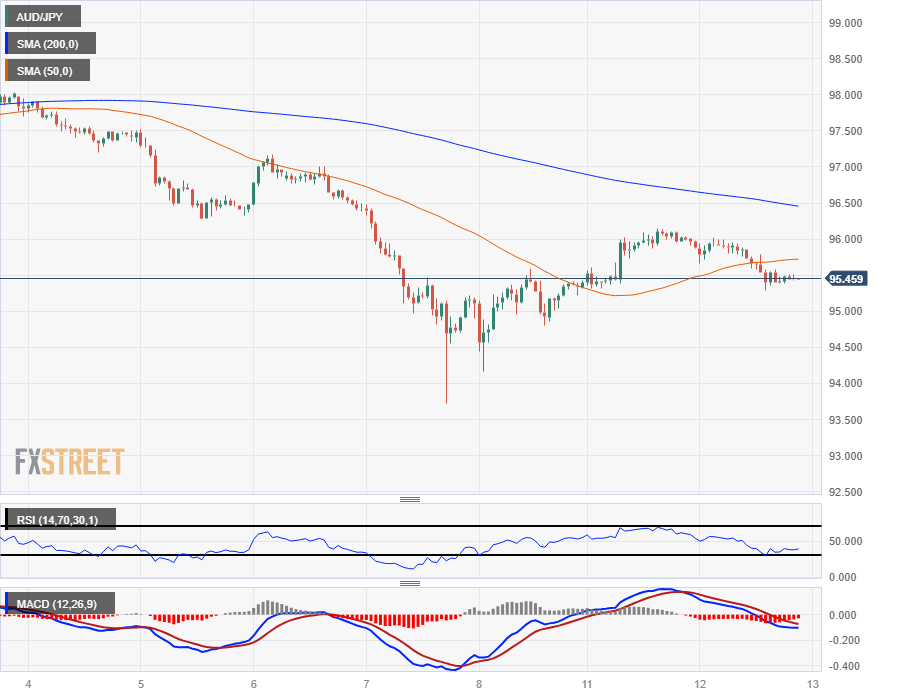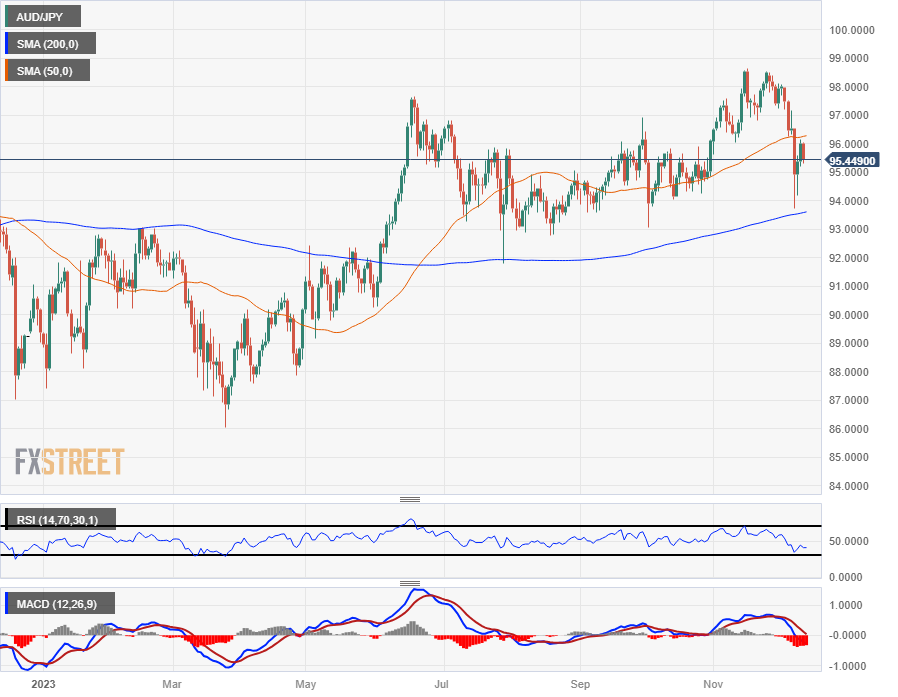- The AUD/JPY is struggling to develop bullish momentum, struggling below 96.00.
- Aussie data continues to pull the rug out from beneath the AUD.
- This week sees a steady smattering of Aussie and Japan data, forecasts remain mixed.
The AUD/JPY couldn’t hold the 96.00 handle on Tuesday, falling back into 94.50 through the day and settling back into the low end. The Australian Dollar (AUD) is one of the worst-performing currencies on Tuesday, falling back against nearly all major currencies on the FX boards for the day.
Early Wednesday brings Japanese Tankan Large Manufacturing Index figures for the fourth quarter, forecast to tick up from 9.0 to 10.0. Tankan Large All Industry Capex for the fourth quarter is forecast to tick down slightly from 13.6% to 12.4%, while the Manufacturing Outlook is expected to shift down from 10.0 to 9.0.
Australian data has been thin this week, though Westpac’s Consumer Confidence for December recovered from -2.6% to 2.7% early Tuesday, providing only minor support for the Aussie (AUD).
Looking further out into the week, Thursday will see Australian employment figures, to be followed up by Judo Bank Purchasing Manager Index (PMI) data early Friday. Aussie Employment Change for November is forecast to shift down from 55K to only 11K, while Friday’s Preliminary Judo Bank Composite PMI for December last came in at a low of 46.2, and further downside could be on the cards as the Australian economy continues to wobble.
Australian Dollar price today
The table below shows the percentage change of Australian Dollar (AUD) against listed major currencies today. Australian Dollar was the strongest against the Canadian Dollar.
| USD | EUR | GBP | CAD | AUD | JPY | NZD | CHF | |
| USD | -0.31% | -0.12% | 0.08% | 0.08% | -0.40% | -0.16% | -0.34% | |
| EUR | 0.31% | 0.18% | 0.40% | 0.38% | -0.11% | 0.14% | -0.04% | |
| GBP | 0.12% | -0.19% | 0.21% | 0.20% | -0.28% | -0.03% | -0.22% | |
| CAD | -0.09% | -0.38% | -0.22% | 0.02% | -0.49% | -0.25% | -0.43% | |
| AUD | -0.08% | -0.39% | -0.22% | 0.02% | -0.50% | -0.24% | -0.44% | |
| JPY | 0.40% | 0.08% | 0.27% | 0.48% | 0.50% | 0.24% | 0.06% | |
| NZD | 0.15% | -0.15% | 0.04% | 0.25% | 0.24% | -0.25% | -0.19% | |
| CHF | 0.33% | 0.04% | 0.22% | 0.44% | 0.44% | -0.07% | 0.19% |
The heat map shows percentage changes of major currencies against each other. The base currency is picked from the left column, while the quote currency is picked from the top row. For example, if you pick the Euro from the left column and move along the horizontal line to the Japanese Yen, the percentage change displayed in the box will represent EUR (base)/JPY (quote).
AUD/JPY Technical Outlook
The Aussie has steadily shed weight against the Japanese Yen in December, declining from the 98.00 handle to test into 94.00 last week, and seeing only a limited recovery that sees the AUD/JPY still capped off by a bearish 200-hour Simple Moving Average (SMA) near 96.50.
Daily candlesticks have the AUD/JPY down from November’s peaks near 98.50, but medium-term momentum continues to find technical support from the 200-day SMA rising into the 94.00 handle.
Bullish momentum remains limited with bids cycling the 50-day SMA since a bullish cross of the 200-day SMA in June near 92.00.
AUD/JPY Hourly Chart

AUD/JPY Daily Chart

AUD/JPY Technical Levels
Information on these pages contains forward-looking statements that involve risks and uncertainties. Markets and instruments profiled on this page are for informational purposes only and should not in any way come across as a recommendation to buy or sell in these assets. You should do your own thorough research before making any investment decisions. FXStreet does not in any way guarantee that this information is free from mistakes, errors, or material misstatements. It also does not guarantee that this information is of a timely nature. Investing in Open Markets involves a great deal of risk, including the loss of all or a portion of your investment, as well as emotional distress. All risks, losses and costs associated with investing, including total loss of principal, are your responsibility. The views and opinions expressed in this article are those of the authors and do not necessarily reflect the official policy or position of FXStreet nor its advertisers. The author will not be held responsible for information that is found at the end of links posted on this page.
If not otherwise explicitly mentioned in the body of the article, at the time of writing, the author has no position in any stock mentioned in this article and no business relationship with any company mentioned. The author has not received compensation for writing this article, other than from FXStreet.
FXStreet and the author do not provide personalized recommendations. The author makes no representations as to the accuracy, completeness, or suitability of this information. FXStreet and the author will not be liable for any errors, omissions or any losses, injuries or damages arising from this information and its display or use. Errors and omissions excepted.
The author and FXStreet are not registered investment advisors and nothing in this article is intended to be investment advice.
Recommended content
Editors’ Picks

How will US Dollar react to February PCE inflation data – LIVE
February Personal Consumption Expenditures (PCE) Price Index, the Federal Reserve's preferred gauge of inflation, from the US will be watched closely by market participants. Investors will scrutinize the data to reaffirm whether the Fed's cautious stance to policy-easing is warranted.

Gold: Record-setting rally remains intact ahead of US PCE data
Gold price refreshes a fresh all-time peak, closing on the $3,100 mark. The global risk sentiment continues to be undermined by worries over Donald Trump's auto tariffs announced earlier in the week, with traders rushing for safety in Gold price. US PCE inflation data awaited.

EUR/USD trades with mild losses below 1.0800, awaits US PCE
EUR/USD is on the back foot below 1.0800 early Friday, struggling to capitalize on the previous day's goodish bounce. Trump's tariff jitters keep investors on the edge, leaving the pair gyrating in a range ahead of the key US PCE inflation data.

Donald Trump’s tariff policies set to increase market uncertainty and risk-off sentiment
US President Donald Trump’s tariff policies are expected to escalate market uncertainty and risk-off sentiment, with the Kobeissi Letter’s post on X this week cautioning that while markets may view the April 2 tariffs as the "end of uncertainty," it anticipates increased volatility.

US: Trump's 'Liberation day' – What to expect?
Trump has so far enacted tariff changes that have lifted the trade-weighted average tariff rate on all US imports by around 5.5-6.0%-points. While re-rerouting of trade will decrease the effectiveness of tariffs over time, the current level is already close to the highest since the second world war.

The Best brokers to trade EUR/USD
SPONSORED Discover the top brokers for trading EUR/USD in 2025. Our list features brokers with competitive spreads, fast execution, and powerful platforms. Whether you're a beginner or an expert, find the right partner to navigate the dynamic Forex market.